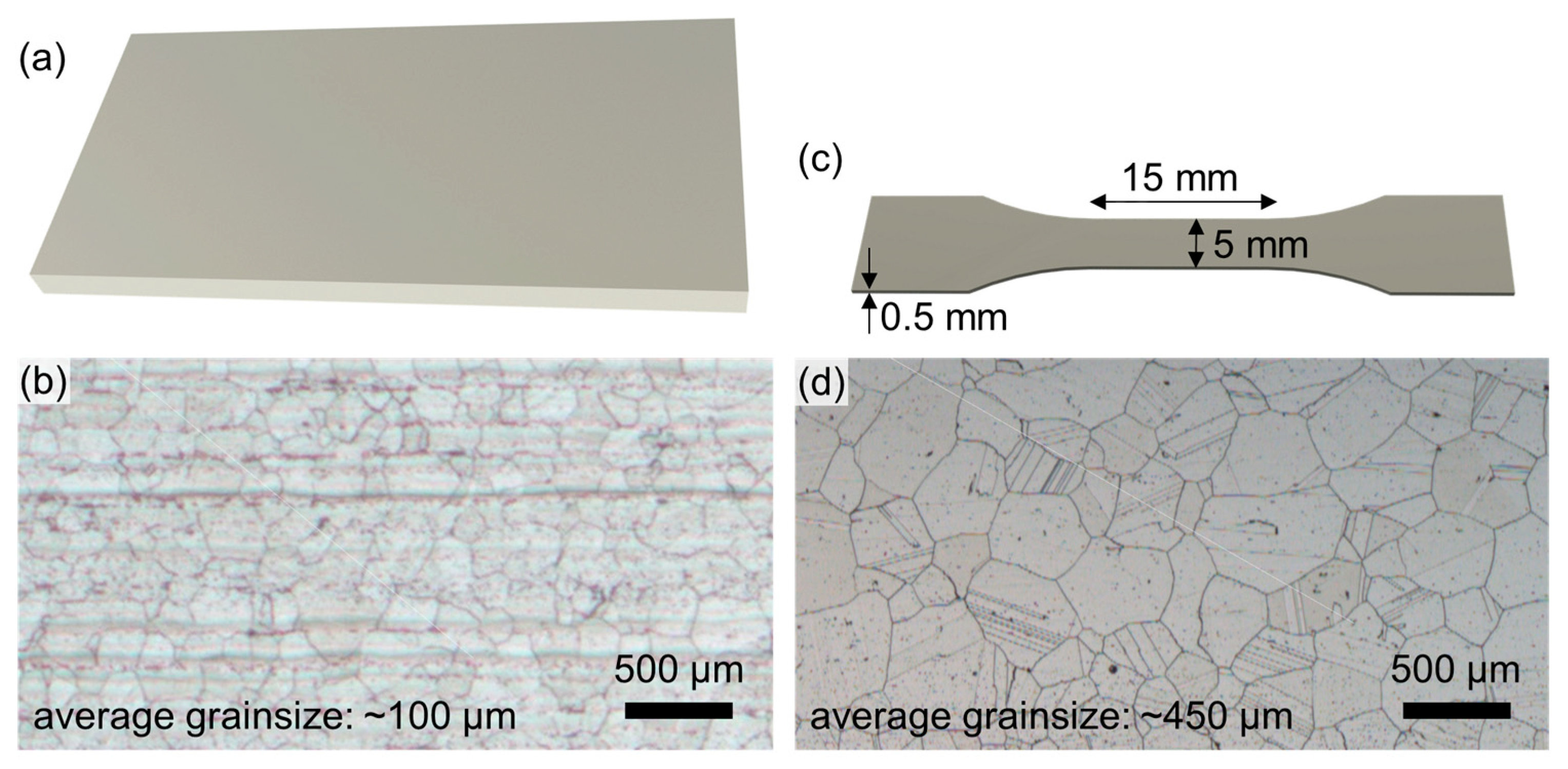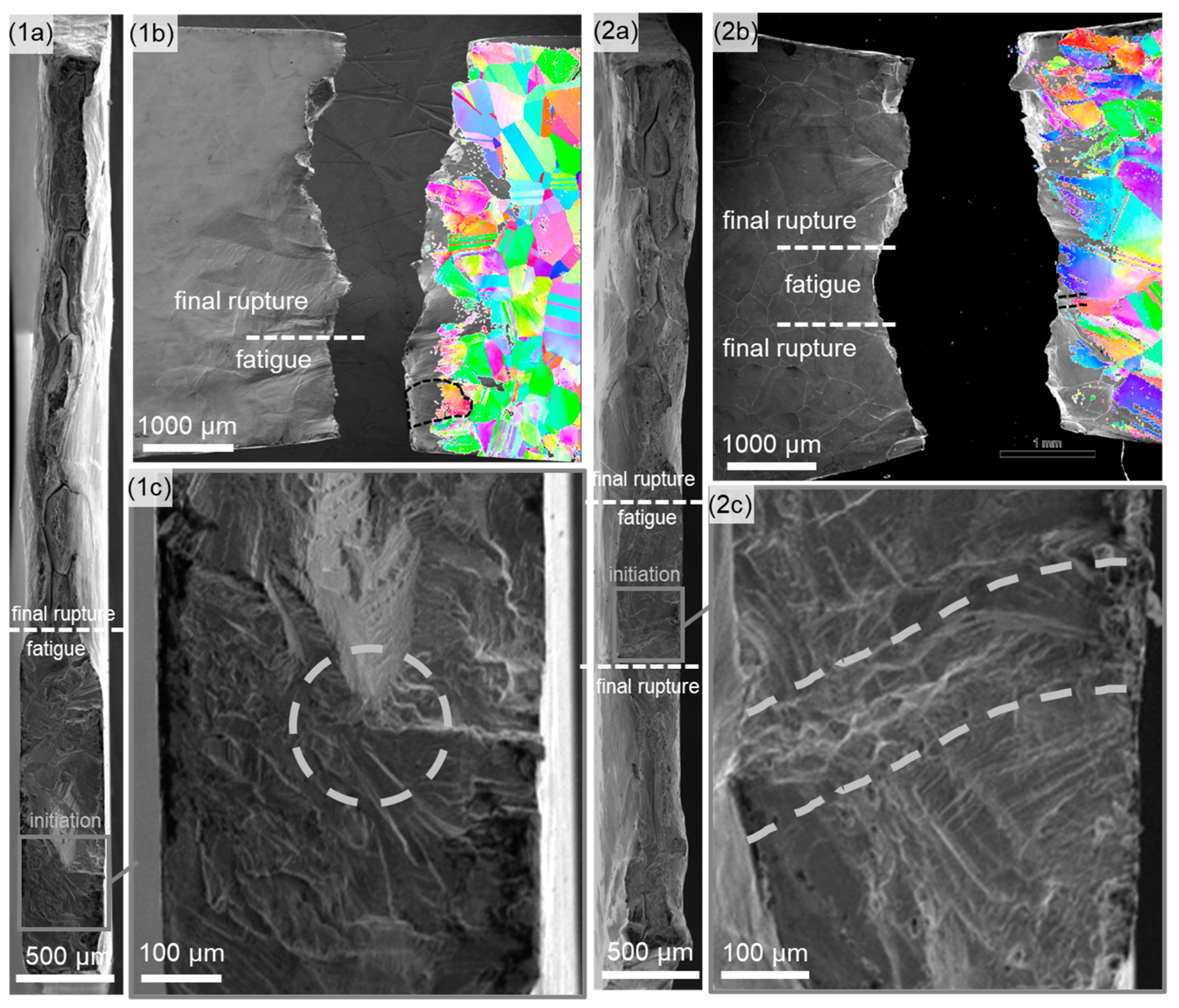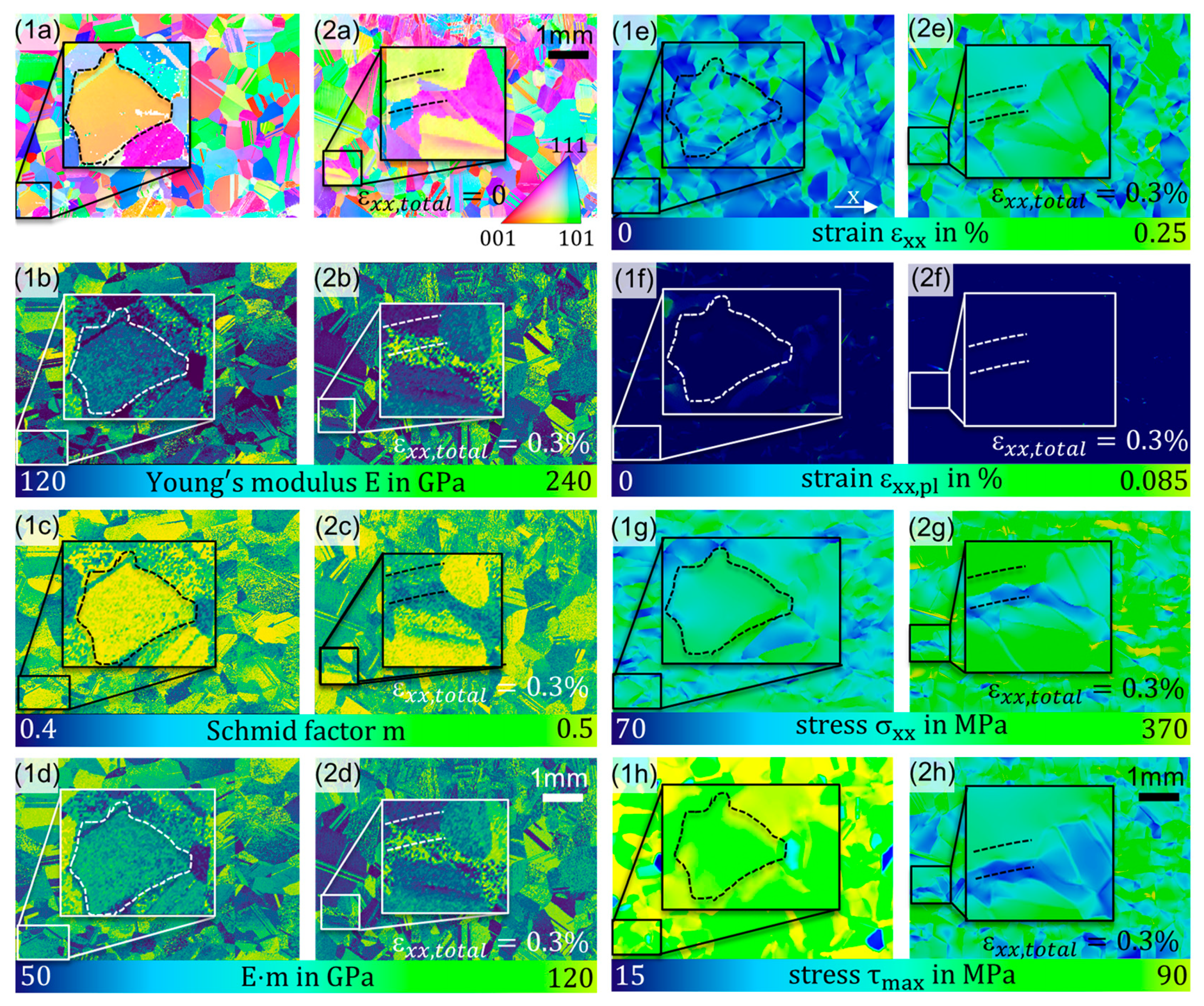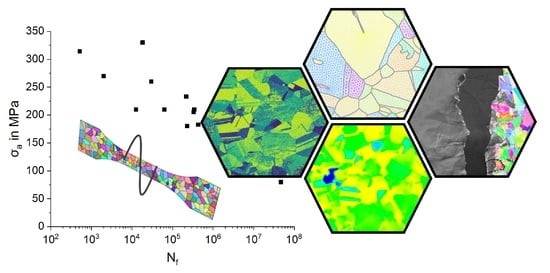Fatigue Analysis of the Nickel-Based Superalloy Inconel 617 by Fatigue Experiments and EBSD Data-Based Finite Element Simulations in Correlation with E·m Theories
Abstract
:1. Introduction
2. Materials and Methods
3. Results and Discussion
3.1. Fatigue Experiments
3.2. Fracture Analyses and EBSD Measurements
3.3. FEM Simulations and E·m Model
4. Summary and Conclusions
Author Contributions
Funding
Data Availability Statement
Acknowledgments
Conflicts of Interest
References
- Reed, R.C. The Superalloys: Fundamentals and Applications, 1st ed.; Cambridge Univ. Press: Cambridge, UK, 2008. [Google Scholar]
- Smith, G.D.; Yates, D.H. Volume 5: Manufacturing Materials and Metallurgy; Ceramics; Structures and Dynamics; Controls, Diagnostics and Instrumentation; Education; IGTI Scholar Award; General; American Society of Mechanical Engineers: New York, NY, USA, 1991. [Google Scholar] [CrossRef]
- Ma, D. Novel casting processes for single-crystal turbine blades of superalloys. Front. Mech. Eng. 2018, 13, 3–16. [Google Scholar] [CrossRef]
- Perrut, M.; Caron, P.; Thomas, M.; Couret, A. High temperature materials for aerospace applications: Ni-based superalloys and γ-TiAl alloys. Comptes Rendus. Phys. 2018, 19, 657–671. [Google Scholar] [CrossRef]
- Zhang, X.; Oskay, C. Polycrystal plasticity modeling of nickel-based superalloy IN 617 subjected to cyclic loading at high temperature. Model. Simul. Mater. Sci. Eng. 2016, 24, 055009. [Google Scholar] [CrossRef]
- Engel, B.; Beck, T.; Moch, N.; Gottschalk, H.; Schmitz, S. Effect of local anisotropy on fatigue crack initiation in a coarse grained nickel-base superalloy. MATEC Web Conf. 2018, 105, 04004. [Google Scholar] [CrossRef]
- Schmitz, S.; Seibel, T.; Beck, T.; Rollmann, G.; Krause, R.; Gottschalk, H. A Probabilistic Model for LCF. arXiv 2013, arXiv:1308.5842. [Google Scholar] [CrossRef]
- Gottschalk, H.; Schmitz, S.; Seibel, T.; Rollmann, G.; Krause, R.; Beck, T. Probabilistic Schmid factors and scatter of low cycle fatigue (LCF) life. Mat.-Wiss. U. Werkstofftech. 2015, 46, 156–164. [Google Scholar] [CrossRef]
- Engel, B.; Mäde, L.; Lion, P.; Moch, N.; Gottschalk, H.; Beck, T. Probabilistic Modeling of Slip System-Based Shear Stresses and Fatigue Behavior of Coarse-Grained Ni-Base Superalloy Considering Local Grain Anisotropy and Grain Orientation. Metals 2019, 9, 813. [Google Scholar] [CrossRef]
- Mäde, L.; Schmitz, S.; Gottschalk, H.; Beck, T. Combined notch and size effect modeling in a local probabilistic approach for LCF. Comput. Mater. Sci. 2018, 142, 377–388. [Google Scholar] [CrossRef]
- Engel, B.; Huth, M.; Hyde, C. Numerical Investigation into the Influence of Grain Orientation Distribution on the Local and Global Elastic-Plastic Behaviour of Polycrystalline Nickel-Based Superalloy INC-738 LC. Crystals 2022, 12, 100. [Google Scholar] [CrossRef]
- Bettge, D.; Österle, W. “Cube slip” in near-[111] oriented specimens of a single-crystal nickel-base superalloy. Scr. Mater. 1999, 40, 389–395. [Google Scholar] [CrossRef]
- Stinville, J.C.; Echlin, M.P.; Texier, D.; Bridier, F.; Bocher, P.; Pollock, T.M. Sub-Grain Scale Digital Image Correlation by Electron Microscopy for Polycrystalline Materials during Elastic and Plastic Deformation. Exp. Mech. 2016, 56, 197–216. [Google Scholar] [CrossRef]
- Charpagne, M.A.; Hestroffer, J.M.; Polonsky, A.T.; Echlin, M.P.; Texier, D.; Valle, V.; Beyerlein, I.J.; Pollock, T.M.; Stinville, J.C. Slip localization in Inconel 718: A three-dimensional and statistical perspective. Acta Mater. 2021, 215, 117037. [Google Scholar] [CrossRef]
- Stinville, J.C.; Echlin, M.P.; Callahan, P.G.; Miller, V.M.; Texier, D.; Bridier, F.; Bocher, P.; Pollock, T.M. Measurement of Strain Localization Resulting from Monotonic and Cyclic Loading at 650 °C in Nickel Base Superalloys. Exp. Mech. 2017, 57, 1289–1309. [Google Scholar] [CrossRef]
- Gräf, M.; Neumayer, S.; Hielscher, R.; Steidl, G.; Liesegang, M.; Beck, T. An Image Registration Model in Electron Backscatter Diffraction. SIAM J. Imaging Sci. 2022, 15, 228–260. [Google Scholar] [CrossRef]
- Engel, B.; Ohneseit, S.; Mäde, L.; Beck, T. Influence of Grain Orientation Distribution on the High Temperature Fatigue Behaviour of Notched Specimen Made of Polycrystalline Nickel-Base Superalloy. Metals 2021, 11, 731. [Google Scholar] [CrossRef]
- Schmidt, E.; Boas, W.; Hughes, F.A. Plasticity of Crystals. J. R. Aeronaut. Soc. 1950, 54, 718–719. [Google Scholar] [CrossRef]
- Ahluwalia, R.; Lookman, T.; Saxena, A. Elastic deformation of polycrystals. Phys. Rev. Lett. 2003, 91, 055501. [Google Scholar] [CrossRef]
- Gonzalez, M.; Axisa, F.; Bulcke, M.V.; Brosteaux, D.; Vandevelde, B.; Vanfleteren, J. Design of metal interconnects for stretchable electronic circuits. Microelectron. Reliab. 2008, 48, 825–832. [Google Scholar] [CrossRef]
- Liesegang, M.; Lion, P.; Beck, T.; Gräf, M.; Steidl, G. Investigation of the tensile deformation behaviour in Ni-based superalloy inconel alloy 617 using EBSD-based finite element simulations and optical flow method. J. Mater. Sci. 2023, 58, 8990–9005. [Google Scholar] [CrossRef]
- Aurenhammer, F. Voronoi diagrams—A survey of a fundamental geometric data structure. ACM Comput. Surv. 1991, 23, 345–405. [Google Scholar] [CrossRef]
- Special Metals (2023) INCONEL® Alloy 617 Data Sheet. Available online: https://www.specialmetals.com/documents/technical-bulletins/inconel/inconel-alloy-617.pdf (accessed on 7 April 2024).
- Skelton, R.P.; Gandy, D. Creep—Fatigue damage accumulation and interaction diagram based on metallographic interpretation of mechanisms. Mater. High Temp. 2008, 23, 345–405. [Google Scholar] [CrossRef]
- Manonukul, A. Multiaxial creep and cyclic plasticity in nickel-base superalloy C263. Int. J. Plast. 2005, 21, 1–20. [Google Scholar] [CrossRef]
- Bachmann, F.; Hielscher, R.; Schaeben, H. Grain detection from 2d and 3d EBSD data--specification of the MTEX algorithm. Ultramicroscopy 2011, 111, 1720–1733. [Google Scholar] [CrossRef]
- Bayerlein, U.; Sockel, H.G. Determination of single crystal elastic constants from de- and dr-Ni-based superalloys by a new regression method between 20 °C and 1200 °C. Superalloys 1992, 10, 695–704. [Google Scholar]
- Chou, P.C.; Pagano, N.J. Elasticity: Tensor, Dyadic and Ingenieering Approaches; Dover Publications Inc.: New York, NY, USA, 1992. [Google Scholar]
- Liang, Z.; Liu, A.; Wang, X.S.; Zhang, N.Q. Experimental and modeling study on small fatigue crack initiation and propagation behavior of Inconel 617. Int. J. Fatigue 2022, 164, 107158. [Google Scholar] [CrossRef]






| Ni | Cr | Co | Mo | Fe | Al | Ti | C | Mn | S | Si | Cu | |
|---|---|---|---|---|---|---|---|---|---|---|---|---|
| min. | 44.50 | 20.00 | 10.00 | 8.00 | 0.80 | 0.05 | ||||||
| max. | 24.00 | 15.00 | 10.00 | 3.00 | 1.50 | 0.60 | 0.15 | 1.00 | 0.015 | 1.00 | 0.50 |
Disclaimer/Publisher’s Note: The statements, opinions and data contained in all publications are solely those of the individual author(s) and contributor(s) and not of MDPI and/or the editor(s). MDPI and/or the editor(s) disclaim responsibility for any injury to people or property resulting from any ideas, methods, instructions or products referred to in the content. |
© 2024 by the authors. Licensee MDPI, Basel, Switzerland. This article is an open access article distributed under the terms and conditions of the Creative Commons Attribution (CC BY) license (https://creativecommons.org/licenses/by/4.0/).
Share and Cite
Liesegang, M.; Beck, T. Fatigue Analysis of the Nickel-Based Superalloy Inconel 617 by Fatigue Experiments and EBSD Data-Based Finite Element Simulations in Correlation with E·m Theories. Crystals 2024, 14, 356. https://doi.org/10.3390/cryst14040356
Liesegang M, Beck T. Fatigue Analysis of the Nickel-Based Superalloy Inconel 617 by Fatigue Experiments and EBSD Data-Based Finite Element Simulations in Correlation with E·m Theories. Crystals. 2024; 14(4):356. https://doi.org/10.3390/cryst14040356
Chicago/Turabian StyleLiesegang, Moritz, and Tilmann Beck. 2024. "Fatigue Analysis of the Nickel-Based Superalloy Inconel 617 by Fatigue Experiments and EBSD Data-Based Finite Element Simulations in Correlation with E·m Theories" Crystals 14, no. 4: 356. https://doi.org/10.3390/cryst14040356






